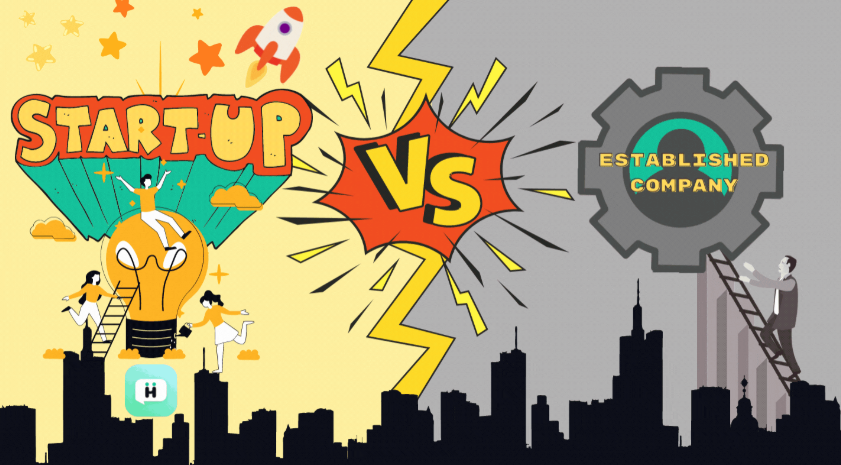Brand Strategy for Startups vs. Established Companies: Key Differences

The path to building a strong brand looks markedly different depending on where an organization sits in its lifecycle. Startups and established companies face contrasting challenges, possess different resources, and navigate unique opportunities when developing and implementing brand strategies. Understanding these differences helps both types of organizations craft approaches that play to their inherent strengths rather than fighting against their natural advantages.
The Foundation: Different Starting Points
Established companies build brand strategies atop existing market positions, customer relationships, and organizational identities. Their challenge isn’t creating awareness from scratch but evolving perceptions that already exist in the marketplace. Like renovating a historic building, they must honor structural elements worth preserving while modernizing outdated features.
Startups, conversely, face the blank canvas challenge. Without established associations or expectations, they have tremendous freedom to define themselves—but must create significance from nothing. Their task resembles architectural creation rather than renovation, requiring different skills and approaches.
As we’ve explored extensively at Brands Dad, these different starting positions influence every aspect of brand strategy development, from research methodologies to implementation timelines.
Resource Realities and Their Strategic Implications
Perhaps the most obvious difference between startups and established companies lies in available resources—not just financial capital but also attention capital, relationship capital, and talent capital. These resource disparities necessitate fundamentally different approaches.
The Startup Resource Reality
Most startups operate with constrained financial resources but abundant attention resources. The founding team can focus intensely on brand development without navigating complex approval processes or competing priorities. This creates several strategic implications:
Speed over perfection: Startups must prioritize getting their brand into the market quickly over getting every element precisely right. Their advantage lies in rapid iteration rather than flawless execution.
Personality over process: With founders typically driving brand development, startup brands often reflect founder personalities and passions. This creates authenticity but can sometimes limit broader appeal.
Direct customer feedback: Without layers of organizational hierarchy, startups directly absorb market feedback, allowing brand evolution to happen organically through customer interaction rather than formal research processes.
When Dollar Shave Club launched, their now-famous video wasn’t the product of extensive market research or brand strategy sessions. Founder Michael Dubin’s comedy background and direct involvement created an authentic voice that immediately differentiated the brand. This founder-driven approach would be nearly impossible within most established companies.
The Established Company Reality
Established companies operate with different constraints and advantages:
Financial resources but divided attention: While budgets may be larger, attention gets divided across numerous priorities. Brand strategy must compete with other initiatives for mindshare.
Expertise but potential groupthink: Large organizations typically have deep marketing expertise but may suffer from internal consensus-building that smooths distinctive edges from brand expression.
Data richness but insight challenges: Established companies often possess vast customer data but struggle to extract meaningful insights from complexity.
When IBM repositioned from hardware company to service and solutions provider, they leveraged their substantial resources to execute a comprehensive brand transformation. The multi-year journey included extensive research, agency partnerships, and coordinated global implementation that would be impossible for a startup to accomplish. However, the process required navigating complex stakeholder relationships and organizational politics that startups simply don’t face.
Risk Tolerance and Decision-Making Dynamics
Perhaps the most profound difference between startups and established companies lies in their relationship with risk. This fundamental difference shapes everything from positioning strategy to creative expression.
Startup Risk Dynamics
For startups, the greatest risk often lies in being ignored rather than being controversial. Without established market presence, they must break through indifference to earn attention. This reality creates several strategic imperatives:
Distinctive over conventional: Startups benefit from strongly differentiated positioning even when it potentially limits broad appeal. Being meaningful to a specific audience outweighs being acceptable to everyone.
Consistency through principles rather than guidelines: Rather than comprehensive brand guidelines, startups often operate from core principles that provide flexibility while maintaining cohesion.
Cultural immersion over documentation: With small teams, startups transmit brand understanding through shared experiences and conversations rather than formal training programs.
Consider how Airbnb developed its early brand. Rather than traditional marketing plans, the founders photographed properties themselves, interacted directly with hosts and guests, and built their brand through storytelling that emerged from these experiences. Their decision to focus on belonging rather than accommodations represented a distinctive choice that established hotel brands would have found difficult to make given their existing associations.
Established Company Risk Dynamics
Established companies navigate different risk equations:
Evolution over revolution: With existing brand equity, radical repositioning risks alienating current customers. Successful brand strategy typically involves evolutionary change that respects existing associations while creating new relevance.
Systematic processes over intuition: Brand decisions impact numerous stakeholders, markets, and product lines, necessitating more systematic decision processes than startups require.
Balancing consistency with flexibility: Established companies must maintain consistency across diverse touchpoints while allowing appropriate flexibility across markets, channels, and business units.
When Microsoft repositioned under Satya Nadella’s leadership, they didn’t abandon their enterprise foundations but rather evolved their brand to embrace more empathetic, human-centered positioning. This shift respected existing equities while creating new relevance—a delicate balance that startups don’t need to maintain.
Audience Relationships and Market Expectations
Startups and established companies face fundamentally different audience dynamics that shape their brand strategy options.
The Startup Audience Reality
Startups begin with no audience expectations, creating both challenge and opportunity:
The credibility hurdle: Without track record or established reputation, startups must overcome initial trust barriers, often by borrowing credibility through partnerships, testimonials, or founder credentials.
The early adopter advantage: Initial customers typically have higher risk tolerance and appreciate being part of something new. This allows startups to engage audiences as co-creators rather than merely consumers.
The narrative opportunity: Without established narratives, startups can shape their story from scratch, developing origin myths and purpose statements that perfectly align with current market needs.
When plant-based meat alternative Impossible Foods launched, they faced significant credibility challenges but leveraged them by turning their unique approach into a compelling narrative. They engaged chefs as early adopters who could testify to product quality while building a movement-based narrative around environmental impact. This approach would be difficult for an established food company with existing associations and diverse stakeholder expectations.
The Established Company Audience Reality
Established companies navigate different audience dynamics:
The expectation burden: Years of customer interactions create expectations that shape future perception. Brand strategies must respect these expectations while creating room for evolution.
The relationship advantage: Existing customer relationships provide channels for sustained communication rather than having to establish initial connections.
The fragmentation challenge: Different audience segments may hold varying perceptions of the brand based on different experiences and historical contexts.
When Burberry rejuvenated their brand under Angela Ahrendts and Christopher Bailey, they had to navigate the complexity of a heritage brand that had different meanings to different audiences—luxury icon to some, dated check pattern to others. Their strategy carefully honored heritage elements while modernizing the brand experience, a nuanced approach that startups simply don’t need to consider.
Implementation Timeline and Measurement Approaches
The timeline for brand strategy development and measurement also differs significantly between startups and established companies.
Startup Implementation Realities
For startups, brand building occurs in concentrated bursts rather than sustained campaigns:
Rapid testing over prolonged planning: Limited runway necessitates getting brand elements into market quickly and refining based on actual response rather than extended planning.
Qualitative insight over quantitative validation: Early-stage metrics focus on qualitative feedback and engagement indicators rather than comprehensive brand tracking studies.
Pivoting as an option: If initial positioning fails to resonate, startups can substantially revise their approach without enormous sunk costs or institutional resistance.
Warby Parker launched with a distinctive brand proposition around affordable, stylish eyewear with social impact. Their initial hypothesis about millennial preferences proved correct, but they continually refined messaging and experience based on customer feedback rather than adhering to rigid brand guidelines. This iterative approach allowed rapid development of brand strength despite limited resources.
Established Company Implementation Realities
Established companies deploy brand strategy through more systematic processes:
Comprehensive planning over rapid deployment: With numerous touchpoints and stakeholders, implementation requires careful coordination across departments, regions, and channels.
Quantitative validation: Significant investments warrant comprehensive measurement through brand tracking studies, sentiment analysis, and attribution modeling.
Training and governance: Ensuring brand consistency across large organizations necessitates training programs and governance structures that startups simply don’t require.
When Mastercard updated their brand identity and positioning to emphasize experiences over transactions, the implementation process took years to fully realize across their global footprint. The complexity of updating everything from physical cards to digital touchpoints across partner banks and thousands of merchants required systematic planning that startups never need to consider.
Strategic Implications: Playing to Inherent Advantages
Understanding these fundamental differences leads to strategic implications for both company types.
Startup Brand Strategy Imperatives
For startups, effective brand strategy means:
Embracing imperfection: Launch with minimum viable brand elements and refine through market feedback rather than seeking perfection before launch.
Leveraging founder authenticity: Build brand directly from founder vision and values rather than constructed personas that may feel inauthentic.
Creating tribal identity: Focus intensely on early adopter communities who can become brand evangelists rather than trying to appeal broadly too early.
Documenting evolution: Capture the startup journey as it happens, creating narrative raw material that can become powerful brand storytelling.
Established Company Brand Strategy Imperatives
For established companies, effective brand strategy requires:
Creating internal alignment before external expression: Ensure organizational readiness for brand evolution through stakeholder engagement and change management.
Bridging heritage and relevance: Honor valuable legacy associations while creating fresh relevance for contemporary audiences.
Balancing global consistency with local relevance: Develop systems that ensure core brand integrity while allowing appropriate adaptation to local market needs.
Integrating brand strategy with business strategy: Ensure brand initiatives directly support broader business objectives rather than functioning as separate marketing exercises.
Conclusion: Different Paths to Brand Strength
Neither the startup nor established company approach to brand strategy is inherently superior. Each represents an appropriate response to different organizational realities and market contexts. The most successful organizations understand their natural advantages and leverage them rather than attempting to operate like their counterparts at different lifecycle stages.
Startups that try to build brands like established companies typically waste precious resources on premature formalization. Established companies that try to act like startups often create organizational whiplash without sustainable change.
The wisest approach recognizes that brand strategy, like all strategic disciplines, must be contextually appropriate—respecting the organization’s current reality while creating pathways toward desired futures. By understanding these fundamental differences, both startups and established companies can craft brand strategies that leverage their inherent advantages rather than fighting against their natural conditions.
For more insights on developing effective brand strategies for organizations at different stages of growth, visit our homepage, where we regularly explore strategic approaches to building brand equity in diverse market contexts.





